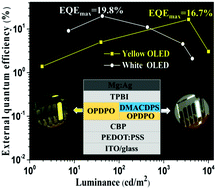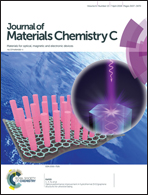Highly-efficient fully non-doped white organic light-emitting diodes consisting entirely of thermally activated delayed fluorescence emitters†
Abstract
Thermally activated delayed fluorescence (TADF) emitters can harvest singlet and triplet excitons for light emission to afford highly efficient organic light-emitting diode (OLED) devices, especially for all-TADF white OLEDs (WOLEDs). However, the majority of TADF emitters suffer from concentration quenching effects and require complicated doping techniques for device fabrication. Herein, we demonstrate a yellow TADF emitter that enables non-doped OLED systems, which is beneficial for the simplification of the OLED device structure and fabrication. The non-doped yellow OLED achieves a maximum external quantum efficiency (EQE) of 16.7% at a high luminance of 3600 cd m−2, in which such a high magnitude is rarely reported. More significantly, by the combination of the yellow TADF emitter with a blue TADF emitter, a fully non-doped emissive layer (EML) strategy has been demonstrated for the fabrication of an all-TADF WOLED, in which the non-doped yellow and blue TADF emissive layers are closely stacked together without any interlayers. The fully non-doped WOLEDs show a maximum EQE of up to 19.8%, along with high quality white-light emission. This is the first report regarding the fully non-doped all-TADF WOLEDs, and the presented design strategy provides a universal route towards the fabrication of simple and efficient WOLEDs.



 Please wait while we load your content...
Please wait while we load your content...